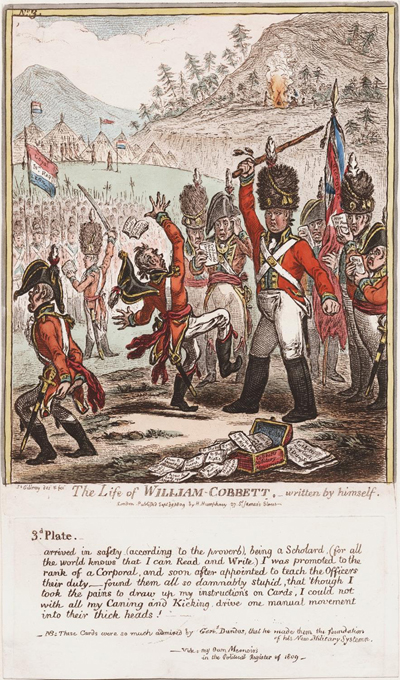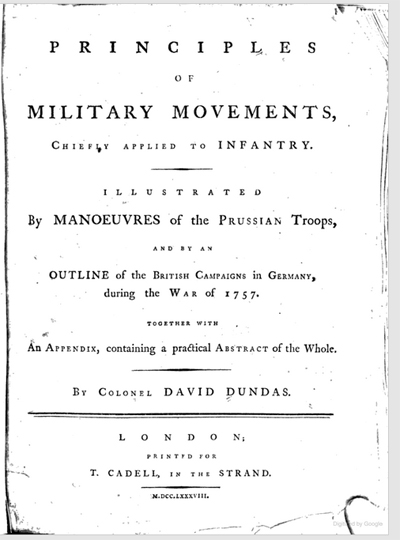The Life of William Cobbett, Written by Himself Pl. 3
This is the third plate in Gillray's eight plate series, The Life of William Cobbett, Written by Himself which pretends to be a kind of graphic autobiography, but is, in fact a not so veiled attack upon Cobbett himself. For the general context of the series in Gillray's work, some background about Cobbett, and the more immediate impetus for the set of plates, see my Introduction.

© Lewis Walpole Library Yale University
The third plate continues the story of Cobbett's life and the satiric program begun in the first plate of having Cobbett's own purported words expose more of his character than he intends.
_arrived in safety_(according to the proverb), being a Scholard, (for all the world knows that I can Read and Write) I was promoted to the rank of a Corporal, and soon after appointed to teach the Officers their duty_found them all so damnably stupid, that 'though I took the pains to draw up my instructions on Cards, I could not with all my Caning and Kicking, drive one manual movement into their thick heads!_NB these Cards were so much admired by Genl Dundas, that he made them the foundation of his New Military Systemn. _Vide: my Own Memoirs in the Political Register of 1809
In this case, his words reveal that in addition to being vainglorious, he is only partially literate, misspelling Scholar and System, referencing a proverb that doesn't exist, and punctuating even more erratically than most 18th century writers.
The graphic reflects Cobbett's inflated view of himself in the caption. It shows him (a mere Corporal) as the virtual leader of his regiment, providing instruction cards to his senior officers for basic troop movements, such as "How to march Forward," "How to shoulder Musquets," "How to hold up Heads," as well as the more ludicrous "How to turn out Toes," "How to Fart to ye Right," and the ever useful "How to Run away." But his students are "damnably stupid," puzzled by the new military system that Cobbett himself has mastered. Indeed, as we see by the box at his feet significantly labeled "Cobbett's Military Cards" Cobbett is nothing loath to take credit for the providing the real inspiration for General Dundas' entire system.

© Google Books
Two themes are carried over from earlier plates. The violence of Plate 1 is continued in the kicking and caning by Cobbett of two of his officer-students. And the suggestion of an unholy alliance of Cobbettt with Lord Edward Fitzgerald and France alluded to in Plate 2 is reiterated in the (anachronistic) tri-colour French revolutionary flags flying over the entire camp.
The text and graphics of the third plate are loosely derived from Cobbett's account of his army service in his Weekly Political Register for June 17, 1809.
While I was a Corporal, I was made clerk to the regiment. . . . About this time, the new discipline, as it was called; that is to say, the mode of handling the musket, and of marching etc. called "Dundas's System," was sent out to us, in little books, which were to be studied by the officers of each regiment, and the rules of which were to be immediately conformed to. . . . To make this change was left to me, who was not then twenty years of age, while not a single officer in the regiment paid the least attention to the matter; so that when the time came for the annual review, I, then a corporal, had to give lectures of instruction to the officers themselves, the colonel not excepted; and for several of them, if not for all of them, I had to make out, upon large cards. . . little plans of the position of the regiment, together with lists of the words of command, which they had to give in the field.(Register: 901)
In this case, the authentic text from Cobbett in the Political Register is, if anything more extreme in its conceit than Gillray's adaptation. While not claiming to have provided the "foundation" for General David Dundas' Principles of Military Movements Cobbett dismisses it as "excessively foolish, from beginning to end" and one that "any old woman might have written." And when speaking of his superior officers, he remembers thinking:
There was I, at the review, upon the flank of the Grenadier Company, with my worsted shoulder-knot and my great, high, coarse, hairy cap' confounded in the ranks amongst other men, while those who were commanding me to move my hands or my feet thus or thus, were, in fact, uttering words that I had taught them; and were, in every thing excepting mere authority, my inferiors, and ought to have been commanded by me.
Sources and Reading
- Commentary from the British Museum on The Life of William Cobbett, Written by Himself Pl. 3..
- Draper Hill, Mr. Gillray The Caricaturist, 1965, p. 117, 144n
- "William Cobbett," Wikipedia
- "David Dundas (British Army officer)," Wikipedia
- The Life and Adventures of Peter Porcupine (1797)
- Cobbett's Weekly Political Register , June 17, 1809
- Thomas Wright and R.H. Evans, Historical and Descriptive Account of the Caricatures of James Gillray #360.
- Thomas Wright and Joseph Grego, The Works of James Gillray, the Caricaturist; With the History of His Life and Times, p. 365-366 .
Comments & Corrections
NOTE: Comments and/or corrections are always appreciated. To make that easier, I have included a form below that you can use. I promise never to share any of the info provided without your express permission.